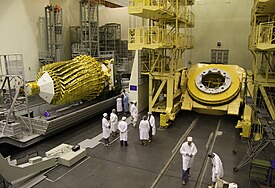 Spektr-R at the integration and test complex of Launch Pad No.31, the Baikonur Space Center in July 2011 | |
| Names | RadioAstron |
|---|---|
| Mission type | Radio telescope |
| Operator | Russian Astro Space Center |
| COSPAR ID | 2011-037A |
| SATCAT no. | 37755 |
| Website | http://www.asc.rssi.ru/radioastron/ |
| Mission duration | Planned: 5 years Achieved: 7 years, 10 months, 11 days |
| Spacecraft properties | |
| Bus | Navigator[1] |
| Manufacturer | NPO Lavochkin |
| Launch mass | 3,660 kg (8,069 lb)[1] |
| Payload mass | 2,500 kg (5,512 lb)[1] |
| Start of mission | |
| Launch date | 18 July 2011, 02:31 UTC[2] |
| Rocket | Zenit-3F[3][4] |
| Launch site | Baikonur Cosmodrome Pad 45/1[2] |
| Contractor | Roscosmos |
| End of mission | |
| Disposal | Equipment failure |
| Declared | 30 May 2019 |
| Last contact | 11 January 2019 |
| Orbital parameters | |
| Reference system | Geocentric |
| Regime | Highly elliptical |
| Semi-major axis | 180,974.7 km (112,452 mi) |
| Eccentricity | 0.905900 |
| Perigee altitude | 10,651.6 km (6,619 mi) |
| Apogee altitude | 338,541.5 km (210,360 mi) |
| Inclination | 42.46° |
| Period | 12769.93 min |
| RAAN | 67.28° |
| Argument of perigee | 244.85° |
| Mean anomaly | 3.07° |
| Mean motion | 0.1126 rev/day |
| Epoch | 24 February 2016, 23:21:29 UTC[5] |
| Revolution no. | 197 |
| Main telescope | |
| Diameter | 10 m (33 ft)[1] |
| Focal length | 4.22 m (13.8 ft)[1] |
| Wavelengths | 92, 18, 6, 1.3 cm[1] |
Spektr program | |
Spektr-R[6] (part of RadioAstron program) (Russian: Спектр-Р) was a Russian scientific satellite with a 10 m (33 ft) radio telescope on board. It was launched on 18 July 2011[7] on a Zenit-3F launcher from Baikonur Cosmodrome, and was designed to perform research on the structure and dynamics of radio sources within and beyond the Milky Way. Together with some of the largest ground-based radio telescopes, the Spektr-R formed interferometric baselines extending up to 350,000 km (220,000 mi).
On 11 January 2019, the spacecraft stopped responding to ground control, but its science payload was described as "operational". The mission never recovered from the January 2019 incident, and the mission was declared finished (and spacecraft operations ended) on 30 May 2019.
- ^ a b c d e f "RadioAstron User Handbook" (PDF). RadioAstron Science and Technical Operations Group. 29 July 2015. Retrieved 1 August 2015.
- ^ a b "Запуск российского научного космического аппарата "Спектр-Р" успешно осуществлен с Байконура" [The launch of the Russian scientific spacecraft "Spektr-R" successfully carried out from Baikonur]. Roscosmos. 18 July 2011. Archived from the original on 21 September 2015. Retrieved 1 August 2015.
- ^ Clark, Stephen (18 July 2011). "Russian satellite on mission to peer inside black holes". Spaceflight Now. Retrieved 1 August 2015.
- ^ Graham, William (8 November 2011). "Russian Zenit-2 launches Fobos-Grunt – Battle on to save mission". NASA Spaceflight. Retrieved 1 August 2015.
- ^ "Spektr-R – Orbit". Heavens Above. 19 February 2016. Retrieved 19 February 2016.
- ^ Zak, Anatoly. "Spektr-R Radioastron". RussianSpaceWeb. Retrieved 15 August 2011.
- ^ Woollacott, Emma (19 July 2011). "Russia launches 'biggest-ever' space telescope". TG Daily. Archived from the original on 15 July 2018. Retrieved 19 July 2011.